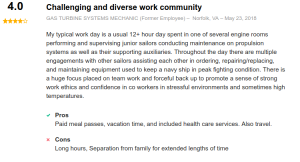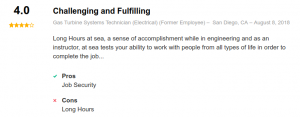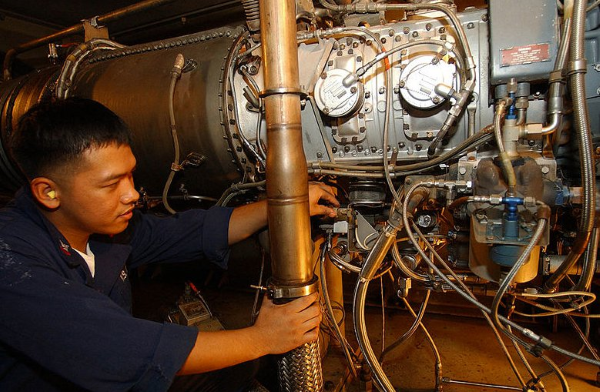Navy Gas Turbine Systems Technicians (GS) are responsible for the operation, maintenance, and repair of the Navy’s gas turbine engines, main propulsion machinery (including shafting, gears, and controllable pitch propellers), propulsion control systems, and assigned auxiliary equipment.
They also operate, repair, and maintain assigned electrical and electronic circuitry up to the printed circuit and alarm warning circuitry in gas turbine systems.
The Navy breaks Gas Turbine Systems Technicians into two separate ratings, Gas Turbine Systems Technicians (Electrical) (GSE) and Gas Turbine Systems Technicians (Mechanical) (GSM).
GSMs focus on the mechanical components of a gas turbine engines, while GSEs concentrate on the electrical components of gas turbine engines.
The United States Navy established the GSM and GSE ratings in 1978.
Related Article – Navy PRT Standards For Males and Females
Jump To A Section
Training And Career Path
What’s Life Like As A GSM?
What’s Life Like As A GSE?
Sea/Shore Rotation
Pay and Benefits
Job Reviews
Civilian Job Opportunities
Requirements and Qualifications
To serve as either a GSM or a GSE in the United States Navy, you must meet certain requirements:
- US citizenship is not required.
- Must be between the ages of 18 and 39.
- Must have a high school diploma or equivalent.
- Must have normal color perception.
- GSM: Must have an Armed Forces Vocational Aptitude Battery (ASVAB) score of VE (Verbal) + AR (Arithmetic Reasoning) + MK (Math Knowledge) + AS (Auto Shop) = 200 or VE (Verbal) + AR (Arithmetic Reasoning) + MK (Math Knowledge) +AO (Assembling Objects) = 205.
- GSE: Must have an Armed Forces Vocational Aptitude Battery (ASVAB) score of VE (Verbal) + AR (Arithmetic Reasoning) + MK (Math Knowledge) + MC (Mechanical Comprehension) = 210 or AR (Arithmetic Reasoning) + MK (Mathematics Knowledge) + EI (Electronics Information) +GS (General Science) = 210.
Related Article: Navy Height And Weight Standards
Training and Career Path
Both GSMs and GSEs, like all other Navy enlisted personnel, must successfully complete eight weeks of Navy Recruit Training, at the Recruit Training Command, Great Lakes (RTC Great Lakes).
Related Article – Navy Fire Controlman (FC): Career Details
Gas Turbine Systems Technicians (Mechanical) (GSM) Training
After RTC, GSMs attend both the Basic Engineering Common Core (BECC) school and Gas Turbine Systems Technician Class “A” school at NTC Great Lakes.
At these schools, the GSMs cover a myriad of topics related to their rating, including Introduction to technical documentation, the Maintenance Material Management System (3M), basic mechanical theory, alignment and operation of piping systems and equipment, safety precautions and programs, lubricants, couplings, bearings, hand tools, precision instruments, propulsion machinery, electrical power and generative distribution, gas turbine engine theory, digital logic control system, and electromechanical and electro-hydraulic servo devices.
Total training time for GSMs after RTC is fifteen weeks and taught via self-paced group instruction and practical application.
Related Article – Is Navy Boot Camp Hard?
Gas Turbine Systems Technicians (Electrical) (GSE) Training
GSEs also attend Basic Engineering Common Core (BECC) school at Great Lakes and go on to GSE Strand Technical School, also at Great Lakes.
At GSE Strand Technical School, the Navy instructs GSEs in the Maintenance Material Management System (3M), basic watch standing procedures, CPR, electrical math, AC/DC circuits, basic schematics, gas turbine engine theory, logic systems, solid state characteristics, introduction to technical documentation, alignment and operation of piping systems and equipment, lubricants and lubricating systems, couplings, bearings, valve, gears, precision instruments, propulsion theory, digital logic control system, electrical power and generative distribution, and electromechanical and electro hydraulic servo devices.
Basic Engineering Common Core school is ten weeks long while the GSE Strand Technical School is 16 weeks long.
What’s Life Like for a Gas Turbine Systems Technician (Mechanical) (GSM)?
Gas Turbine System Technicians (Mechanical) (GSM) perform maintenance on, repair, and operate the mechanical components of propulsion control systems, gas turbine engines, main propulsion machinery, and assigned auxiliary equipment.
The day-to-day duties and activities of a GSM include:
- Use lifting and hoisting devices.
- Maintain special tools.
- Operate and maintain the ship’s service gas turbine generators and support systems.
- Control and maintain the ship’s service steam water chemistry.
- Maintain the controllable pitch propeller system.
- Repair and maintain gas turbine engines and auxiliary equipment.
- Work with schematics, charts, and blueprints.
- Perform administrative procedures related to gas turbine propulsion system maintenance and operation.
- Perform work area inspections.
- Test distillate fuels and lubricating oil and distillate fuels for precipitation, neutralization, and contamination.
- Operate standard test equipment.
- Stop engines to check for proper performance.
- Adust and replace operating tolerance of micro switches, contacts, pressure switches, temperature switches, and relay switches.
- Operate main propulsion equipment and electric plant control.
- Operate air compressors, turning gear, operating pumps, low-pressure air dehydrators, oil purification system, and engineering control systems
- Perform preventive maintenance on both the ship’s fuel system and air system.
- Maintain waste drain system, sea water service system, oil purification system, and manually operated valves.
Related Article – Navy Jobs List: A List Of All 71 Ratings In The US Navy
What’s Life Like for a Gas Turbine Systems Technician (Electrical) (GSE)?
Gas Turbine System Technicians (Electrical) (GSE) perform maintenance on, repair and operate the electrical components of main propulsion machinery, propulsion control systems, alarm warning circuitry, gas turbine engines, auxiliary equipment, and assigned electrical and electronic circuitry up to the printed circuit.
The day-to-day duties and activities of a GSE include:
- Operate electric plant main.
- Operate propulsion control equipment.
- Locate circuit failures and replace parts.
- Measure voltage, resistance, can current.
- Test for shorts, continuity, and grounds.
- Test protective circuitry.
- Replace, test, and service batteries.
- Perform preventive maintenance on control and monitoring circuits and digital data equipment.
- Measure insulation resistance.
- Repair electronic/electrical cables, connectors, and wiring.
- Maintain indicating, alarm, and warning systems.
- Work with schematics, charts, and blueprints.
- Repair and maintain gas turbine engines and auxiliary equipment.
- Adjust and replace operating tolerance of micro switches, pressure switches, temperature switches, and contacts.
- Perform all administrative procedures related to gas turbine propulsion system maintenance and operation.
- Perform work area inspections.
- Operate standard test equipment.
- Stop engines and check for proper performance.
Both GSMs and GSEs normally work in shops or engine rooms that are often noisy and hot aboard ships. While on shore duty, they usually work at training or major repair facilities. Work for both rates is physical, requiring analytical skills for the troubleshooting electronic components.
Navy Gas Turbine Systems Technician (GS) Sea/Shore Rotation
The Sea/Shore Rotation for both a GSM and a GSE are almost identical, with GSMs spending just 2 more months at sea than do GSEs on their first sea tour. Both GSMs and GSEs spend about 65 percent of their time at sea and 35 percent ashore.
| Tour | Sea Tour | Shore Tour |
|---|---|---|
| First Tour | 53 Months (51 for GSEs) | 36 Months (3 Years) |
| Second Tour | 60 Months (5 Years) | 36 Months (3 Years) |
| Third Tour | 48 Months (4 Years) | 36 Months (3 Years) |
| Fourth Tour | 48 Months (4 Years) | 36 Months (3 Years) |
| Fifth Tour | 36 Months (3 Years) | 36 Months (3 Years) |
| Sixth Tour | 36 Months (3 Years) | 36 Months (3 Years) |
| Seventh Tour | 36 Months (3 Years) | 36 Months (3 Years) |
Related Article – Navy Hull Technician (HT): Career Details
How Much Are Gas Turbine Systems Technicians (GS) Paid?
Like all the other Armed Services, the Navy bases a sailor’s pay on their rank and length of service.
| Insignia | Pay Grade | Rank | Abbreviation | 2023 Minimum Monthly Pay |
|---|---|---|---|---|
| N/A | E-1 +4 months | Seaman Recruit | SR | $1,917.60 |
| E-2 | Seaman Apprentice | SA | $2,149.20 | |
| E-3 | Seaman | SN | $2,259.90 | |
| E-4 | Petty Officer Third Class | PO3 | $2,503.50 | |
| E-5 | Petty Officer Second Class | PO2 | $2,730.30 | |
| E-6 | Petty Officer First Class | PO1 | $2,980.50 | |
| E-7 | Chief Petty Officer | CPO | $3,445.80 | |
| E-8 | Senior Chief Petty Officer | SCPO | $4,957.20 | |
| E-9 | Master Chief Petty Officer | MCPO | $6,055.50 | |
| E-9 | Command Master Chief Petty Officer | CMDCM | $6,055.50 | |
| E-9 | Master Chief Petty Officer Of The Navy | MCPON | $6,055.50 |
As are all sailors, GSMs and GSEs may be entitled to other forms of compensation including base allowance for housing (BAH), base allowance for subsistence (BAS), sea pay, etc.
The Navy (COOL) website claims that opportunities for placement in both the GSM rating and the GSE rating are excellent. The Navy also reports that advancement opportunities for GSMs are at or above average, while they rate advancement opportunities for GSEs “well above average” for sailors E7 and below.
Job Reviews
Reviews on the career website indeed.com by former and current GSMs and GSEs vary wildly.
One former GSE described time in the Navy as “the best years of my life.”
However, another complained, “In addition to the long hours and days away from home, the pay is not always equivalent to the pay of the civilian job. I personally don’t think the ships are managed well.”
Here is a sampling of review from indeed.com by both GSMs and GSEs:






The Department of the Navy’s Credentialing Opportunities Online (COOL) website estimates there are only about 2,800 sailors serving as Gas Turbine Systems Technicians (Mechanical) (GSM) in the Navy today, while there are 1,200 men and women serving as Gas Turbine Systems Technicians (Electrical) (GSE).
Both Gas Turbine Systems Technicians, GSM and GSE, ratings require a 5 year (60 months) service commitment.
Related Article – Pros and Cons Of Joining The Navy
Civilian Career Opportunities
GSMs and GSEs retiring or departing the Navy have a great deal of opportunities available to them after their service.
A few of these include:
- Engine and other machine assembler (GSM)
- Industry machinery mechanic (GSM)
- Machinery maintenance worker (GSM)
- Hazardous materials removal worker (GSM)
- General maintenance and repair worker (GSM/GSE)
- Power plant operator (GSM/GSE)
- Pump operator (GSM/GSE)
- Ship engineer (GSM/GSE)
- Boiler operator (GSM/GSE)
- Stationary engineer (GSM/GSE)
- Electrical engineering technician (GSE)
- Electronics and electrical repairer (GSE)
- Electrical and electronics installer and repairer (GSE)
- Electrician (GSE)
- Electrical power line installer and repairer (GSE)
Like all sailors, both GSMs and GSEs should take full advantage of the on-the-job (OJT), training opportunities, and educational opportunities offered and afforded them during their naval service.
Related Article: 10 Best Jobs In The Navy For Civilian Life
The United States Military Apprenticeship Program (USMAP) also allows both GSMs and GSEs to complete several civilian apprenticeship requirements while on active duty to get their US Department of Labor (DOL) nationally recognized “Certificate of Completion” in preparation of life outside the Navy.
There are 32 national certifications available for GSMs, while there are 45 available for GSEs. Multiple state licenses are obtainable by both rates, too.
Conclusion
Young men and women looking for a promising career, desiring to serve their county, and wishing to see the world will do themselves a favor by researching and considering the GSE and GSM ratings.
References
Official Navy Mechanical and Industrial Technology Careers Page
Navy Personnel Command Gas Turbine Systems Technician (Electrical) (GSE) Overview
Navy COOL Summary For Gas Turbine Systems Technician (Electrical) (GSE)
Navy COOL Gas Turbine Systems Technician (Electrical) (GSE) Rating Card
Navy Personnel Command Gas Turbine Systems Technician (Mechanical) (GSM) Overview
Navy COOL Summary For Gas Turbine Systems Technician (Mechanical) (GSM)
Navy COOL Gas Turbine Systems Technician (Mechanical) (GSM) Rating Card
Navy Gas Turbine Systems Technician (Electrical) (GSE) Reviews – indeed.com
Navy Gas Turbine Systems Technician (Mechanical) (GSM) Reviews -indeed.com
- Gas Turbine Systems Technician (GSM and GSE): Career Details - June 18, 2024
- Interior Communications Electrician (IC): 2023 Career Details - June 18, 2024
- Religious Program Specialist (RP): 2023 Career Details - June 18, 2024
Originally posted on September 16, 2019 @ 5:52 pm
Affiliate Disclosure: This post may contain affiliate links. If you click and purchase, I may receive a small commission at no extra cost to you. I only recommend products I have personally vetted. Learn more.
